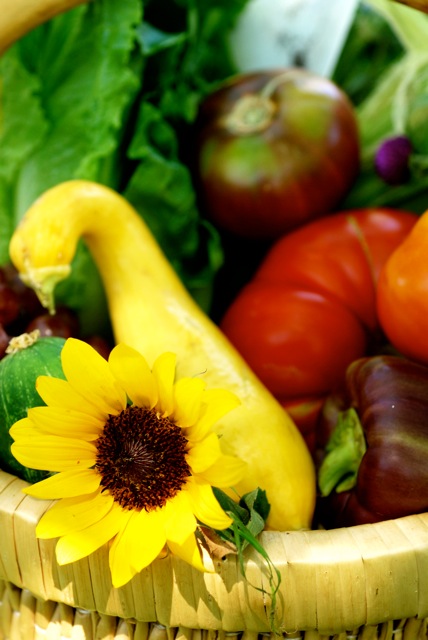 I woke up this morning to the low hum of my food dryer, a regular happy summer sound as I transform my extra garden produce into food that we can use all winter long. Drying is such an easy way to do it!
I woke up this morning to the low hum of my food dryer, a regular happy summer sound as I transform my extra garden produce into food that we can use all winter long. Drying is such an easy way to do it!
Every morning we go out into the garden and pick the day’s harvest, and whatever we aren’t going to use that day goes right into the food dryer. It only takes a few minutes to wash it, and lay it or slice it onto the trays. I keep my food dryer in the laundry room and it runs night and day during the summer. It takes very little energy, and makes very little noise or heat. Right now I have it loaded with kale and sliced yellow squash.
I’ve found the easiest way to use nutritious garden kale all winter long is to dry it and crumble the leaves into flakes. It is amazing how small of a jar a whole harvest basket full of kale can fit into, once it is dried! I label these jars and tuck them into my spice cupboard. It is so handy to sprinkle kale into anything I am cooking: soups, casseroles, even scrambled eggs. I use kale all year long!
To dry kale, I cut the center fibrous stalk out of the leaf before loading the kale onto the drying trays, or if I am in a hurry, I put the whole leaf on the drying tray and just crumble the dried leaf away from the harder stalk and discard the stalk (actually all my “discard” goes to the chickens!)
Kale is dry to the brittle stage overnight and my dryer is ready to load again! You don’t have to be exacting about time in the dryer: 10 hours or 20 hours yields about the same results. If you put the temperature up too high, you can get some over-dried brown spots, so keep it at medium heat. No need to wash the trays, as any food remnants on the trays are very dry and preserved . . . and besides, those bits are most welcome to join the next batch of dried food that goes into my spice jars!
Yellow squash and zuchinni, which every gardener tends to have too much of, makes a wonderful dried cooking ingredient. I slice it and load it onto the trays and when it is very dry and brittle, I let it cool on the trays and then fill my blender with it and buzz it into a crumbled powder. Into a glass jar it goes, labeled and in my spice cupboard. Shaking this “squash powder” into soups thickens them well, and adds nutrition and flavor! It’s great in baking too—add it to muffins (zuchinni muffins are good, right?) . . . and add it everywhere. I shake it into spaghetti sauce or sprinkle it ontop of my homemade pizza.
Everything you cook can be nutrition packed with summer’s fresh flavors and high vitamin/mineral content. I’ve often thought that we don’t need to take a vitamin pill, with all the “shaking” out of these jars that I do when I cook. You don’t really taste the kale or the squash, but the whole dish tastes richer and looks flecked with lovely colors!
What do I dry, powder and pack into jars?
- beet greens
- kale
- chard
- collards
- eggplant
- tomatoes
- zucchini
- yellow squash
- green beans
- parsley
- herbs
All the extra fresh herbs that I have in abundance: dill, basil, thyme, oregano, parsley, lemon balm, rosemary, mint are quick drying and fabulously fresh-tasting in winter meals. (Herbs can also be successfully frozen for extra delicious fresh taste! )
And here’s a list of what I do not dry and preserve from my summer garden:
- radishes
- sugar snap peas (I freeze those)
- winter squash (store in a cool place instead, as they last well)
- potatoes (same as squash)
- beets
- carrots (you can buy these already dried quite inexpensively)
- onions (these too!)
- cucumbers
- melons
- soft fruits
I’d rather freeze berries, peaches, plums, etc. as they turn great frozen. Hard fruits such as apples are great dried, but once again, it is so inexpensive to buy dried apples that unless you have huge abundance, it is probably not worth the labor.) And you can make fruit leather with the food dryer too.
If you don’t have a food dryer, you can dry some things such as herbs by hanging them. See my directions here.
Or even better, buy yourself a food dehydrator! It’s a great investment! Let me recommend my favorite food dryer. If you’d like to buy one now, I’ll give you an additional $5 off my already on-sale price! (Type “BLOG” in the comment box at checkout, so we can give you the discount as we process your order.) If you have a big garden, is it really handy to get the extra trays. I keep mine all loaded up. You’ll use it all summer long!
Do you need a food drying book so you know what you are doing? No, not really. It is basic and easy stuff: just slice the food so it is only about 1/4″ to 1/2″ thick—more or less—and dry it until it is brittle feeling. That’s the sum total idea from the many drying books I’ve read. If you leave moisture in the food, it may mold. Food dried to “brittle” will last for years and years and years. It takes moisture for bacteria and mold to ruin food, so don’t leave any in. And then make sure you store your food in an air-tight container. Like a jam jar or peanut butter jar. I don’t buy jars, I just recycle grocery store food jars and spice jars. Keeping them in the dark (in an amber jar, or inside a cupboard rather on the counter) make them retain their vitamins better. I have green pepper strips and mushrooms I dried ten years ago that are still great.
I usually add my dried foods in crumbled or powdered form to what I am cooking or baking and it reconstitutes itself, but if you have a mind to reconstitute dried food separately, simply place it in a dish and cover with hot tap water, about 5 x as much water as food, approximately. Set it aside and in awhile (10 to 60 minutes, depending on the thickness of the food), it will look like regular food again, sorta. It is amazing how compact dried food is!
If you are in a real hurry to reconstitute your dried food, just add it to boiling water and simmer for a few minutes. I’ve made plum spread to use as a pancake topping out of dried plums in 5 minutes on the stovetop.
Summer’s nutrition, all packed neatly in jars to cook with all winter long. I love it!
Okay, what are we waiting for? Get that dryer loaded up!
P.S. You can buy the “too-much-trouble-to-dry” foods already dried and canned for you, inexpensively here:
 Dried Carrots |
 Dried Onions |



Comments on this entry are closed.